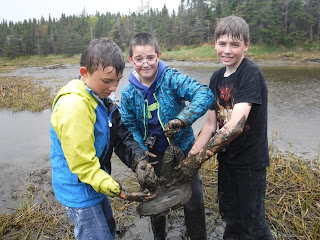Did you know that there are 5 classes of wetland in Canada? Learn to recognize them and get acquainted with the wetlands near you. You can learn about all 5 classes of wetland in greater detail by reading the Canadian Wetland Classification System. This post is Part 3 of a 5 Part series entitled Know Your Wetland Classes.
The theme this week is swamps. You can find Part 1 of the series (Fens) here, and Part 2 (Bogs) over here.
Swamps are forested wetlands, and are often found in riparian areas next to rivers or lakes, or in the transition zone between bogs and fens. They are not as wet as other wetland classes, such as fens or marshes, and the drier conditions allow for trees and/or shrubs to dominate. The hydrologic regime varies throughout the year and from swamp to swamp: they may be seasonally wet or have standing water throughout the whole year.
The theme this week is swamps. You can find Part 1 of the series (Fens) here, and Part 2 (Bogs) over here.
Swamps are forested wetlands, and are often found in riparian areas next to rivers or lakes, or in the transition zone between bogs and fens. They are not as wet as other wetland classes, such as fens or marshes, and the drier conditions allow for trees and/or shrubs to dominate. The hydrologic regime varies throughout the year and from swamp to swamp: they may be seasonally wet or have standing water throughout the whole year.
There are three types of swamp:
shrub, coniferous, and hardwood (deciduous). The
understory is shaded and is ideal for plant species that can tolerate shade.
- Conifer swamp: White cedar, pine and spruce trees are common
- Hardwood swamp: Dominated by maple, willow, aspen, oak and birch trees
- Shrub swamps: Have small trees and bushes such as willow, alder and dogwood
 |
| Shrub swamp, Newfoundland and Labrador. Photo credit: Nature Conservancy of Canada staff. |
What lives in a swamp?
Swamps are important nesting areas for many species of birds. Forexample, wood ducks, common mergansers and goldeneyes nest in hollow cavities in the dead standing trees, called snags. Other animals, such as reptiles, fish, and amphibians depend on the shallow, muddy waters to
reproduce and have offspring. Here in Newfoundland and Labrador we commonly see large
mammals such as moose roaming around our swamps.
The stagnant waters are also great breeding areas for
dragonflies, mosquitoes and other insects. Because of this, many swamps have been
drained, filled, and cleared. Although these bugs can seem pesky to us, they
actually provide food for frogs, ducks and other wildlife that reside there. As we continue to realize the importance of wetlands, like swamps, for wildlife habitat, they have become a higher priority for conservation and stewardship initiatives. Many SAM member municipalities have signed wetland habitat stewardship agreements with the provincial government, to safeguard important wetlands in their community for future generations of wildlife and people.
 |
| Moose near Hawke's Bay, NL. Photo credit: NL Wildlife Division staff. |




